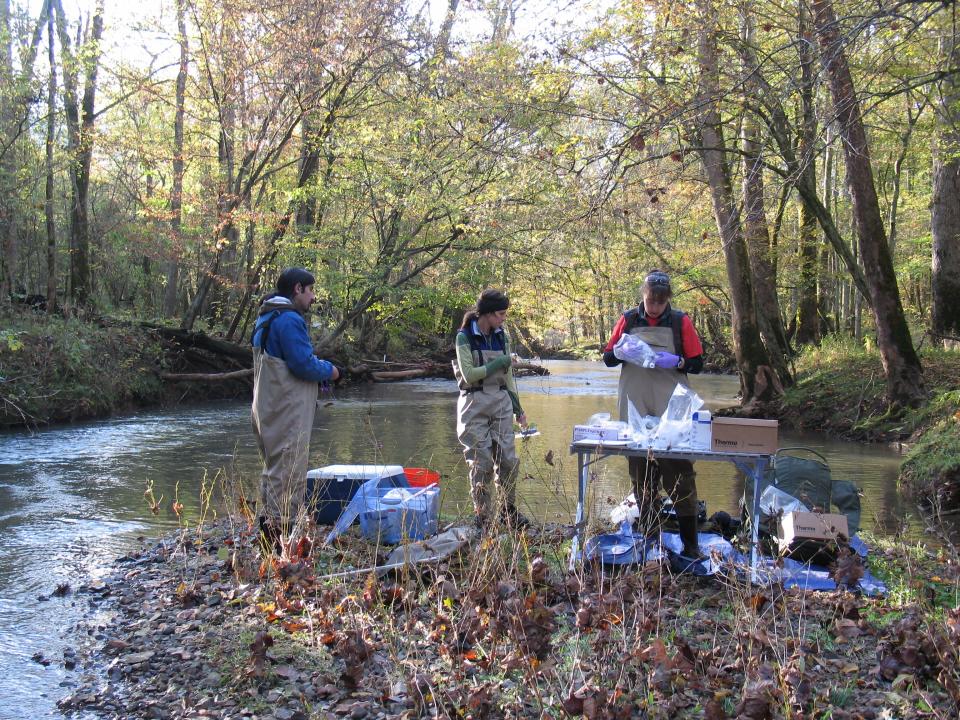How an ORNL discovery could guide mercury remediation
In 2012, researchers at Oak Ridge National Laboratory “made one of the biggest discoveries in the field of mercury pollution in a couple of decades or so,” said Jerry Parks.
It was a remarkable feat considering that Parks said he knew very little about mercury when he joined ORNL in 2008 as a postdoctoral researcher. Today he is group leader of the Molecular Biophysics Group in the lab’s Biosciences Division.
The discovery was published in the journal Science in 2013, and he described the discovery and its aftermath in a recent talk to Friends of ORNL.

The team discovered two genes (which they named hgcA and hgcB) that enable some bacteria to convert inorganic mercury in soil and waterways into methylmercury. This toxic compound is taken up by fish and can become highly concentrated.
Humans who eat too much contaminated fish can suffer ill health effects. Methylmercury (MeHg) is a potent neurotoxin that penetrates the blood-brain barrier and damages the central nervous system.
It has been known for more than 50 years that inorganic mercury can be transformed in lakes and streams into toxic methylmercury and that certain anaerobic bacteria – the kind that grow in oxygen-free environments – cause the conversion. But details on how the conversion occurs was not known until the discovery at ORNL.
Parks’ quest to figure out how bacteria methylate mercury was partly inspired by what he learned about vitamin B12, which is present in our food and multivitamin pills. In the 1960s, it was discovered that the vitamin could transfer a methyl group to mercury. In the 1990s a group identified a biochemical pathway that involved vitamin B12 to make methylmercury.
Parks learned that a protein that binds vitamin B12 and is involved not in mercury methylation, but in a closely related biochemical pathway had a known structure. He suspected that a similar protein that binds vitamin B12 could be responsible for making methylmercury. At the same time, he and his colleagues examined the genomes of six different mercury-methylating bacteria.
Using their skills in bioinformatics, Parks and his colleagues “searched for a gene that encodes a unique protein that can bind vitamin B12 and that is present only in the genomes of mercury-methylating bacteria,” Parks said. “And we found not just one gene, but two genes that make mercury-methylating proteins.”
But to confirm they had identified the two genes responsible for mercury methylation, their colleagues at ORNL and collaborators at the University of Missouri had to develop a way to “knock out” one or both of the suspect genes in two different kinds of bacteria.
“They showed that when the hgcA and hgcB genes are present, the bacteria make a lot of methylmercury,” Parks said. “But when they knocked out one or both genes, the bacteria no longer produced methylmercury. When the genes were added back into each organism, then they were able to make methylmercury again.”
Mercury researchers are still pondering a mystery.
“We still don’t know why certain bacteria put a methyl group onto mercury,” Parks said. “Does it help them get rid of the mercury?” he asked. “They are no less susceptible to mercury toxicity than bacteria that don't methylate mercury. Is it an accident? Is it a weapon? Do they make methylmercury and stick it out in the environment to kill their competitors? Maybe. I would really like to know.”
Asked about practical applications of the discovery of the mercury-methylating genes, Parks said, “Now that we know which genes are responsible, scientists can go into any environment in the world, scoop up a sample of soil or seawater, and search for those genes. If they are present in the environmental samples, that’s a red flag.
What needs to be be learned
“The lesson is that we need to be careful about allowing mercury from industrial processes to enter the environment. There are ways that people involved in environmental remediation can collect mercury using absorbent material and then sequester it, isolating it from the environment.”
Parks said it is inadvisable to try to prevent the anerobic bacteria from methylating mercury in waterways, saying, “You’ve got to be careful about unintended and possibly harmful consequences.”
This article originally appeared on Oakridger: An ORNL discovery could guide mercury remediation

